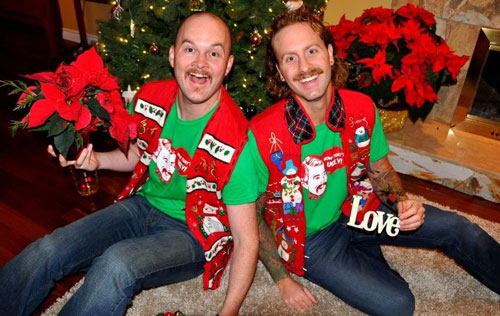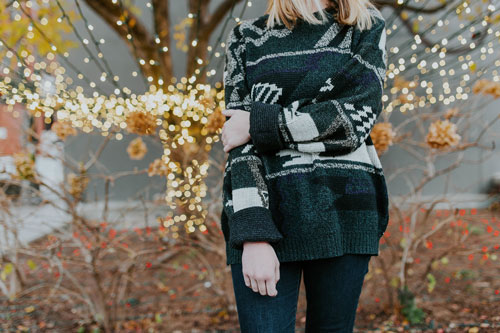Hey all, Ernie here with another issue of Tedium by Andrew Egan. Last time he showed up on Tedium, he broke down NYC's now-repealed dancing ban, and before that, he told us about professional cornhole. Now, he's talking sweaters.
Today in Tedium: Some simple inventions took a surprising amount of time to create. Case in point: The can opener was invented 45 years after the can. Reasons for these delays tended to result from technological gaps rather than a lack of Ingenuity. This is especially important when considering the sweater, a winter staple not readily available to the masses until the 19th century. And amazingly, it be nearly another century until Christmas sweaters caught on. Today's Tedium takes an in-depth look at the humble holiday sweater, the scratchy, cozy gift we love to watch others receive. — Andrew @ Tedium
Loot, the ladies’ room, and a pair of matching handguns. Curious? Subscribe to the newsletter the NYTimes calls ‘stunning’ and receive the latest from Topic.
Today's issue is sponsored by Topic. (See yourself here?)
$140k
The amount of money (in Canadian dollars) raised by Chris Boyd and Jordan Birch for local charities over a 13-year period with their Ugly Christmas Sweater Party, held annually at the Commodore Ballroom in Vancouver. The pair claim to have started the Ugly Christmas Party trend in 2001.

Chris Boyd, left, and Jordan Birch. (via the The Original Ugly Christmas Sweater Party Facebook page)
The two British Columbian guys who made ugly Christmas sweaters a thing
The modern ironic appreciation for ugly Christmas sweater starts in the early 2000s with themed parties that allegedly started in Canada and quickly spread to the United States, along with routine appearances in pop culture.
By 2008, the Vancouver Sun was reporting that Boyd and Birch's Ugly Christmas Sweater Party was bringing in over 1,000 woolen clad devotees. Despite a sudden explosion in popularity, the ugly Christmas sweater trend didn't spring from nowhere. The duo first noticed the trend of garish, holiday themed sweaters while visiting relatives and working in retirement homes.
"So these sweaters have been around for a long time," Boyd told a Canadian television station in 2013. "At the time, I was working at a retirement home and Jordan was inspired by his Aunt Mary's sweater … So we thought, why not have a theme party based on these sweaters?"
Some of the earliest documented photos of the Vancouver Ugly Christmas Parties date back to 2003, when it was basically a sparsely attended house party. As word traveled, Boyd and Birch noticed the parties were getting bigger. "The party doubled in size the second year, then doubled in size the next," the Los Angeles Daily News reported in 2007.
Google search trends show an increase in interest year over year for the term "Ugly Christmas Sweater" but the explosion happens in 2014. Eventually, Live Nation, one of the world's largest event management companies, promoted the 2015 and 2016 Commodore Ugly Christmas Sweater Parties. A simple idea between two friends to spread holiday cheer had finally gone corporate.
16 to 22
The number of hours required to hand-knit a basic, one color sweater, according to a professional knitter and YouTube personality. Another knitting blogger (knitting is a really vibrant community) counted 70,532 stitches in a completed handmade sweater.

Before they were ugly: The historic lineage of the sweater
Pinning down an exact date for the creation of the sweater is a little complicated as hand-spun garments made from wool have been made for centuries. These proto-sweaters are better described as tunics.
The sweater we know and love today was first developed for fishermen in the Channel Islands in the 15th century. A May 1971 National Geographic article frames the early popularity of the sweater, often called a "jersey," as a competition between two of the Channel Islands, Jersey and Guernsey:
Most of these seamen still wear the traditional "fisherman's jersey," a sweater that is naturally called a guernsey on Guernsey. The islands' knitting industry, though, began not with sweaters but with stockings. Elizabeth I reputedly clothed her royal limbs in hand-knitted jerseys, and cousin Mary Queen of Scots was executed in them. (Guernsey claims she wore guernseys.) So profitable was the trade that farmers left their fields to knit, and in 1608 the Jersey States decreed the stocks for anyone over 15 caught knitting at harvest time.
Due to the labor-intensive process of making sweaters by hand, the now-ubiquitous garment was slow to disseminate. With advanced manufacturing available by the mid-1800s, sweaters were adopted by the British Royal Navy—particularly the thick, woolen variations given to submariners, noted for their thick necks associated with modern turtleneck sweaters. Some elements of the British military still wear them today.
As the 20th century approached, sweaters had expanded beyond their coastal roots to find mainstream popularity. Fashion designers begin marketing a high-end patterns and materials to the famous and well healed. College athletes in America began touting their accomplishments with their varsity sweaters. (One college football player for the University of Alabama, Benjamin Russell Jr., worked with his dad to create a wool-free version of the sweater, the sweatshirt, leading to the creation of the famed Russell Athletics brand.)
But it was World War II that would shape the future of sweaters in weird and wonderful ways.
1M
The number of Army-standard sweaters the Citizens for the Army and Navy, a volunteer group, set to produce by Christmas of 1941, according to Life. The group set their goal several months before the December attacks on Pearl Harbor.

(Foundry/Pixabay)
How World War II was a turning point for the sweater as a cultural phenomenon
The mobilization of millions of soldiers, sailors, and their support during the Second World War meant the creation of supply chains unprecedented in human history. Cover stories and articles in Life and Time magazines called on Americans, especially women, to contribute to the war effort by knitting. One 1940 Time article noted, "The men hardly have time to grab their guns before their wives and sweethearts grab their needles and yarn."
Poetic reminders of war rationing aside, millions of Americans and Brits spent the war years making sweaters, hats, and socks in prodigious numbers. One community knitting group just south of Seattle churned out 244 knitted garments in three months. Each member of the group knitted 1.5 hours a day on average.
(It should be noted that the World Wars also helped to popularize T-shirts.)
After the war, economic prosperity lead to an explosion of consumer goods, including higher quality yarn in a stunning array of newly available colors.
Sweaters as everyday wear hit peak fashion in the 1950s. With tighter fibres and stitching methods, a baggy, practical defense against the elements became high fashion. One 1952 film on "Sweater Girls" noted, "The sweater has come of age. It's now stylish with a capital 'S'!... Seems right now everyone is wearing them."
When watching that film, one key element jumps out. Before the 1950s, sweaters where largely just woven wool without frills or bobbles. As sweaters became an icon of elegance, designers decided to add more to gather attention, including costume jewelry and intricate designs.
For millions of skilled knitters forged by war time conditions, high fashion was an investment in yarn and time away. Today, Pinterest and knitting forums are filled with vintage patterns from the 1940s and 50s. Everything from simple cardigans to form-fitting show stoppers. And if you look a little closer, there are also a fair amount of patterns for Christmas sweaters.
It would be easy to attribute the origin of the modern ugly Christmas sweater to 1980s pop culture, specifically Bill Cosby and Chevy Chase. Yet neither ever wore ugly Christmas sweaters. This was Chevy Chase in Christmas Vacation:

The scandal-plagued and disgraced Cosby, once a television icon, definitely wore ugly sweaters, but his Christmas versions were on par with Chevy's, fairly subdued. Plenty of news outlets attribute these two as the originators of the ugly Christmas sweater, but that ignores an interesting history.
In the inevitable Ugly Christmas Sweater Party Book, the authors write: "Our neighbors to the north were trying to figure out what to do with a surplus of ugly Christmas sweaters that they had amassed since Canada was founded in 1867."
Canada also had a vigorous wartime knitting program, as well as the ruthless winters to keep such skills alive.
But it could be argued that no one is responsible for the ugly Christmas sweater. It just happened and, over time, people noticed. Ugly sweaters in general had their moment in the 1980s and early 1990s with Carlton from The Fresh Prince of Bel-Air and Zack Morris from Saved By the Bell carrying the tradition from Cosby. Ugly Christmas sweaters happened because some of us have relatives who like to knit. Our mothers, grandmothers, and others knitted out of practicality and care. A generation of knitters combined with the fact that Christmas has a specific color palette that is notorious for clashing created the conditions for the ugly sweaters we celebrate today.
Every hand knitted sweater comes from a place of tradition, history, and love. When they're Christmas-themed, well, those are best left to very specific parties.





